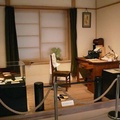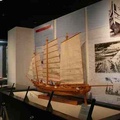One sunny day in August, I was on the way to go back to my new place in Kaimuki near the University of Hawaii. That day, I took a walk to the Kaimuki Shopping center to acquire some household implements for my new place. I had four plastic shopping bags and felt thirsty under the bright sun, so I decided to take a rest at a McDonald’s. Outside the McDonald’s on the Waealae there was a small triangle park having a few trees and benches. I sat down and started looking at the group of pigeons on the ground. They were eating food because there was someone feeding them from a nearby bench. “Are you tired from the life?” said the person sitting on the bench. I looked back at him. It was a local Japanese male, heavy-set and in the late fifties. He started to talk to me about his illness and taking care of the pigeons as a healing ritual. It was my first time to “talk-story” in Honolulu after I came back from Japan where I grew up. I learned from my past experience living in Hawaii for six years that local Japanese are happy to talk with native Japanese about anything Japanese. They like to display their knowledge about Japanese food or language. That was the case here.
I was not uncomfortable to have a conversation with him, but I was in a hurry and wanted to leave. I gradually stood up to excuse myself. He said that he wanted to ask me one last thing. He said, “Have you seen yuki-onna? You said you are from a cold place in Japan.” “No, I think that is a folktale in the Tōhoku region.” He hurried to add, “I am very interested in… because I experienced those things here!” Then for the next ten minutes this sansei, named Gary, kept talking about his strange experiences with ghosts while he was working at the Diamond Head National Park as a night guard—listening to Hawaiian night marchers in a bush or the voice of an invisible cat (personal communication, August 10, 2007). I found that I had chicken skin on my arms and my forehead was sweating. His stories brought back to me the ghost tales I heard as a child in Japan. Ghost stories are a natural part of growing up in Japan, so it felt natural to be talking to a local Japanese about the supernatural.
Many people in Hawaii seem to have fondness for supernatural tales like the Japanese, and many supernatural tales I heard in Hawaii were similar to those I heard in Japan. One case in particular caught my attention. Beginning in May 1959 a faceless woman started to be seen in the Waialae Drive-in Theatre in Kahala, Oahu. The story was first reported in The Honolulu Advertiser (1959) by the notable reporter Bob Kraus. In the next 32 years the faceless female was reported seen by numerous people who used the bathroom in the theatre. Glen Grant, another respected reporter, considered this story to be just another urban myth when he shared his opinion about the faceless woman during a radio show in 1989. But a caller talked about her first-hand experience of the ghost. This first-hand account triggered his curiosity and he gathered other first-hand accounts that happened between 1965 and 1992. These reports were incorporated into Grant’s well-known book, Obake Files (1996).

Glen Grant (1947-2003) In “Storyteller upheld spirit of Moiliili” by Chun. G.C. W. Honolulu-Star Bulletin, 2003, June 20.
In an article written in The Hawaii Herald (1983), Grant identified the faceless Hawaiian ghost as mujina, which is the name of a trickster spirit popular in Japan. Grant compares the Hawaiian ghost called mujina to a faceless ghost found in a story of Patrick L. Hearn (known as Lafcadio Hearn) called “Mujina,” saying that “the mujina in both the Hawaiian and Japan tales are striking similar” (p. 8A). He suggests that the Hawaiian ghost must have its ancestor in this ghost story in Japan because there are no faceless female ghosts in American or Polynesian ghost literature. Since Grant made the connection between the faceless female ghost in Honolulu and the faceless ghost in Lafcadio Hearn, most people assume the ghost has its origins from Japan but is adapted to Hawaiian culture. The question is how the Japanese ghost became so integrated into contemporary Island society that people of other ethnic backgrounds could also see and talk about it as their own ghost (Grant, 1983).
Although the Hawaiian mujina was probably influenced in important ways by Japanese types of ghosts, I will examine Grant’s assumption that there must be a derivation from the Japanese mujina. I will argue that the varied features of the Hawaii mujina confuses or conflates a number of ghost story complexes originating from Japan or China, and therefore this modern Hawaiian ghost has made a more complex journey to Hawaii through its Japanese immigrant culture than Grant assumes. I will suggest some ways that the basic elements of the faceless female might have come to Hawaii following the end of the Edo Period when the first Japanese immigrants came to Hawaii.
To understand the earlier Japanese sources of this particular ghost story in the twentieth century Hawaii, we must study the main features of the mujina ghost story in Hawaii first. She is a female ghost with no face. This seems to be the most important thing reported about it. Most people say they saw only blank flesh where the face should be, yet one person described a dark tunnel between the head and the body. The ghost is also commonly described to have beautiful long hair, which is sometimes covering her face. Some witnesses report that she was combing her hair when they saw her. Others reported that her hair was red. Along with the beautiful hair, she is reported to be young and beautiful in some undefined way, but also frightening in the next moment.
When the Hawaiian mujina appears, she can be walking or standing, but it is reported that she has no feet. She hovers over the ground. She does not avoid the gaze of witnesses, but even tries to get their attention. She is described as rude at times, banging on a bathroom door while a witness was using it. To others she appeared drunk or sick. According to Grant (1996), three people who have seen her later died. Does she have an eternal life? She ends up frightening those who see her, but there is no clear proof that she is trying to harm people.
Many of these characteristics of the ghost can be found in ghosts all over the world. But there is no doubt that early Japanese immigrants brought ghost stories very similar to this one with them to Hawaii. The image of a beautiful but frightening female ghost has deep roots in Japanese culture in Hawaii, and can be found in a variety of forms of popular entertainment. In many Japanese horror films, for example, a female dies unnaturally and returns to get revenge, especially on men. It was a cultural practice among Japanese Americans, from the 1920s to the 1940s, when issei parents started to bring their children to theatres in downtown Honolulu to watch Japanese horror films, and following generations kept this form of entertainment alive as a part of city culture until the 1950s (Brian Niiya, personal communication, October 29, 2007).
Notes:
1. Female ghosts who appear in winter mountains or villages and are believed to take lives of human beings, especially in Northeast Japan (Tōhoku).
2. According to the Resource Center Director Brian Niiya at Japan Cultural Center in Hawaii, the similar practice was seen in California in those days. The purpose of this movie habit would be strengthening the next generations’ Japanese language.
© 2011 Kaori Akiyama





